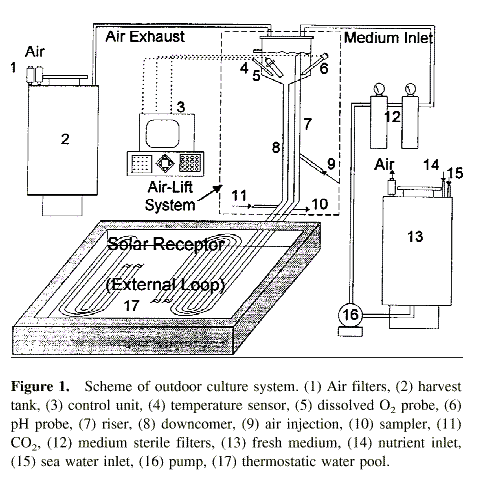
| |
 |
![]()
I have found two web sites that dispel the myth that school children cannot grow spirulina and do it well. In fact, one of those websites discusses a Helical Tubular system which looks very easy to build. And I imagine it could be built for less than $500. The students are using it to study carbon dioxide removal but they are using spirulina to do that. I hope that I can learn enough to design a system that feeds me.
Also, you might be interested to visit the following web address. This is a company that sells Tubular Photobioreactors and I have to say I am impressed with the info they sent me in the mail however, as always, the cost of their system may be very high (they did not list prices) but I think one could build their own system modeled after something like this for a fairly low price. In this article there is a neat little diagram of an air lift system. As you know, the shearing effect on the spirulina cells in typical pump systems has a negative impact and therefore it seems like many systems opt for the air lift pump, which uses compressed air to “lift” the water. Also, this system features a cooling/heating mechanism which could be important in outdoor environments.
A Model for Light Distribution and Average Solar Irradiance Inside Outdoor Tubular Photobioreactors for the Microalgal Mass Culture excerpts, by FG Acie´ n Ferna´ ndez, F Garci´a Camacho, JA Sa´ nchez Pe´ rez, JM Ferna´ ndez Sevilla, E Molina Grima
Industrial-scale biomass production of highly valuable chemicals, such as those used in the fine-chemical and phar-maceutical industries, is today one of the most important challenges facing microalgal biotechnology (Ben-Amotz and Avron, 1989). Until a few years ago, this production was carried out in quasiartisan facilities essentially made up of open ponds. These ponds were later improved with temperature control systems, supplies of appropriate nutrients, optimization of pond depth, CO 2 injection systems, etc. In spite of these improvements, productivity remained fairly low, moreover, only the production of certain microalgal species was pos-sible. Closed reactors soon began to appear for large-scale production of the so-called ‘‘sensitive’’ strains with higher productivities (Richmond, 1990).
Many very different designs for a reactor of this kind such as outdoor open ponds (Terry and Raymond, 1985), vertical alveolar panels (Tredici and Materassi, 1992), flat plate reactors (Ratchford and Fallowfield, 1992), tubular reactors (Pirt et al., 1983; Gudin and Thepenier, 1986; Richmond et al., 1993), etc., have been proposed. Among them, the tubular photobioreactor, in which the circulation of fluids is induced by bubbling air, allows better control of the culture variables, enabling higher productivities, and reducing power consumption and cellular stress (Gudin and Chaumont, 1991; Molina Grima et al., 1994c).
Both photobioreactors are made of Plexiglas with an airlift system to recirculate the fluid and an external loop which acts as solar receiver submerged in a thermostatic pond of water. The walls of the pond were unpolished and painted white to increase the reflection of the solar radiation. The air-lift was made up of a degasser in which the dissolved oxygen, pH, and temperature probes were in-serted, all of them connected to an on-line control unit and a computer for data monitoring and backup (Molina Grima et al., 1994c, 1995).

Offered by Glenn.